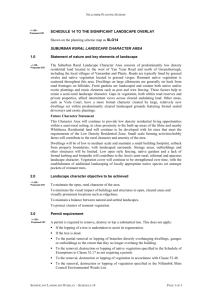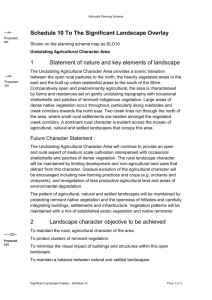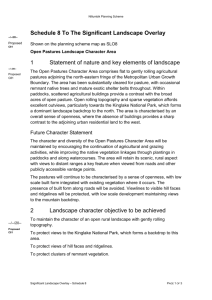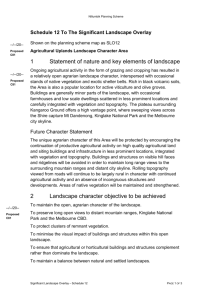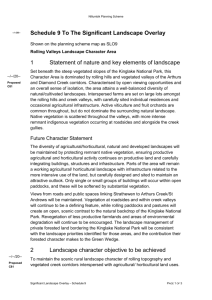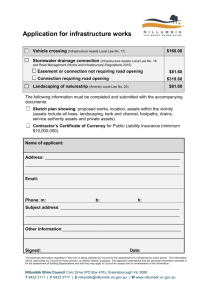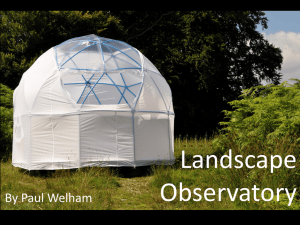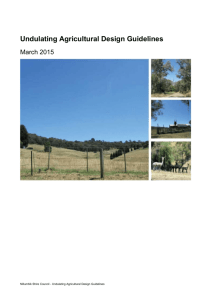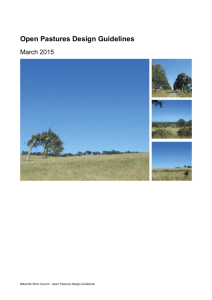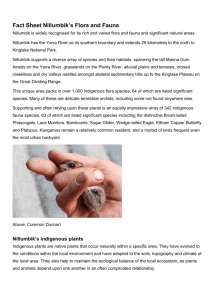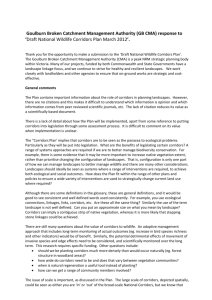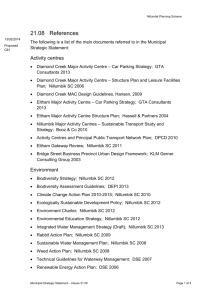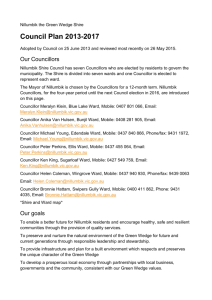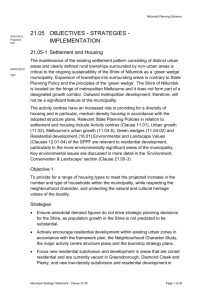Proposed C81 - Nillumbik Shire Council
advertisement
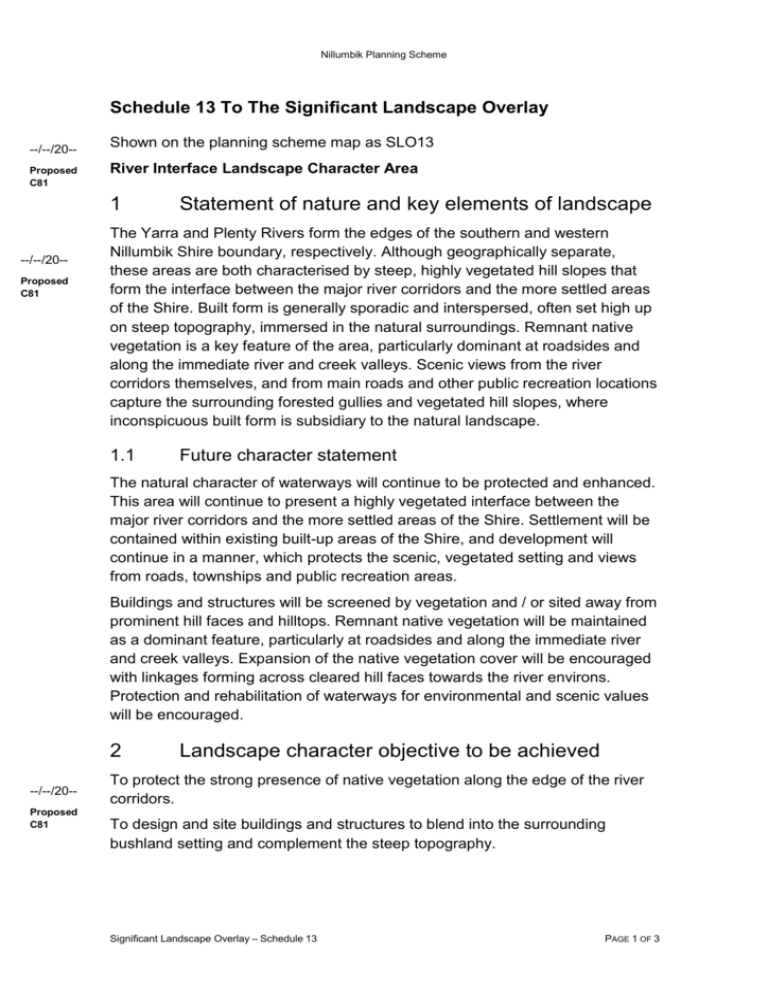
Nillumbik Planning Scheme Schedule 13 To The Significant Landscape Overlay --/--/20-Proposed C81 Shown on the planning scheme map as SLO13 River Interface Landscape Character Area 1 --/--/20-Proposed C81 Statement of nature and key elements of landscape The Yarra and Plenty Rivers form the edges of the southern and western Nillumbik Shire boundary, respectively. Although geographically separate, these areas are both characterised by steep, highly vegetated hill slopes that form the interface between the major river corridors and the more settled areas of the Shire. Built form is generally sporadic and interspersed, often set high up on steep topography, immersed in the natural surroundings. Remnant native vegetation is a key feature of the area, particularly dominant at roadsides and along the immediate river and creek valleys. Scenic views from the river corridors themselves, and from main roads and other public recreation locations capture the surrounding forested gullies and vegetated hill slopes, where inconspicuous built form is subsidiary to the natural landscape. 1.1 Future character statement The natural character of waterways will continue to be protected and enhanced. This area will continue to present a highly vegetated interface between the major river corridors and the more settled areas of the Shire. Settlement will be contained within existing built-up areas of the Shire, and development will continue in a manner, which protects the scenic, vegetated setting and views from roads, townships and public recreation areas. Buildings and structures will be screened by vegetation and / or sited away from prominent hill faces and hilltops. Remnant native vegetation will be maintained as a dominant feature, particularly at roadsides and along the immediate river and creek valleys. Expansion of the native vegetation cover will be encouraged with linkages forming across cleared hill faces towards the river environs. Protection and rehabilitation of waterways for environmental and scenic values will be encouraged. 2 --/--/20-Proposed C81 Landscape character objective to be achieved To protect the strong presence of native vegetation along the edge of the river corridors. To design and site buildings and structures to blend into the surrounding bushland setting and complement the steep topography. Significant Landscape Overlay – Schedule 13 PAGE 1 OF 3 Nillumbik Planning Scheme To preserve scenic views from the river corridors to surrounding waterways, hills and gullies. To minimise the visual impact of buildings and structures within open areas of the landscape. 3 --/--/20-Proposed C81 Permit requirement A permit is required to remove, destroy or lop a substantial native tree. This does not apply If the lopping of a tree is undertaken to assist its regeneration. If the tree is dead. To the partial removal or lopping of branches directly overhanging dwellings, garages or outbuildings to the extent that they no longer overhang the building. To the removal, destruction or lopping of native vegetation specified in the Schedule of Exemptions to Clause 52.17 as not requiring a permit. To the removal, destruction or lopping of vegetation in accordance with Clause 52.48. To the removal, destruction or lopping of vegetation specified in the Nillumbik Shire Council Environmental Weeds List. A permit is not required to construct a building or construct or carry out works for: An alteration or extension (including an outbuilding normal to a dwelling) to an existing dwelling or building used for agriculture provided all of the following are met: The height of the alteration or extension is less than 7 metres above the natural ground level; The alteration or extension is located at least 5 metres from the base of any substantial native tree; The floor area of the alteration or extension to an existing dwelling is less than 50 percent of the gross floor area of the existing building or 100 square metres, whichever is the lesser; The floor area of the alteration or extension to an existing outbuilding or building used for agriculture is less than 10 percent of the gross floor area of the existing building or 100 square metres, whichever is the lesser; Significant Landscape Overlay – Schedule 13 PAGE 2 OF 3 Nillumbik Planning Scheme The external surfaces, including roofs and walls, of the alteration or extension are clad and maintained in non-reflective materials coloured in muted tones; The top of the roof line of the alteration or extension is lower than the top of the ridgeline located directly behind the site of the extension or alteration. A permit is required to construct a fence. This does not apply to: Open post and wire fences of less than 1.2 metres in height. Post and mesh wire rabbit proof fences of less than 1.2 metres in height. Temporary fencing for construction sites. Transparent safety fence for a swimming pool located in the immediate vicinity of the swimming pool. A permit is required for earthworks that comprise more than 1 metre cut or fill. Meaning of terms For the purpose of this clause a ‘substantial tree’ means a tree that has a diameter at breast height (DBH) greater than 0.16m at 1.4m above the ground. For the purpose of this clause a ‘horticultural structure’ means a structure, which provides a controlled growing environment for horticulture or plant nursery use, including plastic igloos, shade houses and glasshouses. 4 --/--/20-Proposed C81 --/--/20-Proposed C81 Application requirements An application must be accompanied by a landscape plan showing proposed landscape works and plantings. 5 Decision guidelines Before deciding on an application, the responsible authority must consider, as appropriate: Vegetation and Landscaping The type, extent, quality and significance of any tree to be removed. The extent and type (species) of new planting. The extent to which any proposed landscaping screens buildings and structures viewed from road corridors and public spaces. The extent to which the siting of the proposed buildings and works has minimised the need for the removal of native vegetation. Views and Vistas Significant Landscape Overlay – Schedule 13 PAGE 3 OF 3 Nillumbik Planning Scheme Whether the proposed development will maintain views from public land and road reserves towards hill faces and ridgelines. Whether the proposed development will maintain views of Kinglake National Park. The cumulative impact of all buildings and works visible from road reserves and public land on the landscape character of the area. Buildings and Structures The extent to which the development follows the natural topography of the land and minimises the need for earthworks. The prominence of the building along ridgelines, hill faces and elevated areas when viewed from a road reserve or public land. The setback of the building from property boundaries, river and creek corridors and roads. The scale, massing and roof form of the building. Whether the proposed development sits below the existing tree canopy. Whether the proposed development utilises non-reflective materials coloured and maintained in muted tones that are consistent with the natural setting. The location and siting of tennis courts. Rural Buildings and Structures The scale and siting of the proposed buildings and structures. Whether the proposed development utilises non-reflective materials coloured and maintained in muted tones that are consistent with the natural setting. Fencing, Access and Driveways The height and materials used to construct any proposed fencing. The extent to which roads, access tracks, driveways and car parking areas conform with the topography and maintain vegetation as a screen. The materials used to construct the proposed road base, access track or driveway. 6 --/--/20-Proposed C81 Reference Documents Nillumbik Landscape Character Assessment (Planisphere, 2009). River Interface Design Guidelines (Nillumbik Shire Council, March 2015) Significant Landscape Overlay – Schedule 13 PAGE 4 OF 3
